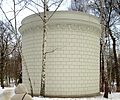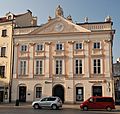Neoclassical architecture in Poland was centered on Warsaw under the reign of Stanisław August Poniatowski, while the modern concept of a single capital city was to some extent inapplicable in the decentralized Polish–Lithuanian Commonwealth.[1][2][3] Classicism came to Poland in the 18th century as the result of French infiltrations into the Polish millieu.[4] The best-known architects and artists who worked in Poland were Dominik Merlini, Jan Chrystian Kamsetzer, Szymon Bogumił Zug, Stanisław Zawadzki, Efraim Szreger, Antonio Corazzi, Jakub Kubicki, Hilary Szpilowski, Christian Piotr Aigner, Wawrzyniec Gucewicz, Bonifacy Witkowski and Danish Bertel Thorvaldsen.[5]





The first stage, called the Stanislavian style, followed by an almost complete inhibition and a period known as the Congress Kingdom classicism.[6] The palladian patterns were independently interpreted by Szymon Bogumił Zug, who followed an influence of radical French classicism.[7] A palladian by influence was also Piotr Aigner - architect of the façade of St. Anne's Church, Warsaw (1786-1788) and St. Alexander Church (1818-1826).[7] Palladian ideas were implemented in a popular type of a palace with a pillared portico.[7]
The most famous buildings of the Stanislavian period include the Royal Castle, Warsaw, rebuilt by Dominik Merlini and Jan Christian Kamsetzer, Palace on the Water, Królikarnia and the palace in Jabłonna. Kamsetzer erected the Amphitheatre in the Royal Baths Park and the Warsaw palaces of the Raczyńskis and Tyszkiewiczs as well as the palace in Iskierniki. Among the most notable works by Szymon Bogumił Zug is a palace in Natolin and Holy Trinity Church and gardens: Solec, Powązki, Mokotów and Arcadia near Nieborów.
From the period of the Congress Kingdom are Koniecpolski Palace and the St. Alexander's Church, Warsaw, the Temple of the Sibyl in Puławy, rebuilding the Łańcut Castle. The leading figure in the Congress Kingdom was Antonio Corrazzi.[7] Corazzi created the complex of Bank Square in Warsaw, the Palace of the Ministry of Revenues and Treasury, the building of the Staszic Palace, Mostowski Palace and designed the Grand Theatre. Belvedere and Pawłowice were created by Jakub Kubicki, while Lubostroń Palace and Dobrzyca Palace by Stanisław Zawadzki. The notable town halls in Łowicz, Płock, Błonie, Konin and Aleksandrów Łódzki are dating back the first half of the nineteenth century.
Stanislavian classicism gallery
- Palaces
- Łazienki Palace in Warsaw, 1764-1795
- Marynka Palace in Puławy, 1790-1794
- Królikarnia Palace in Warsaw, 1782-1786
- Skórzewski Palace in Lubostroń, 1795-1800
- Poniatowski Palace in Jabłonna, 1775-1779
- Lubomirski Palace in Niezdów, 1776-1804
- Potocki Palace in Natolin, 1780-1782
- Gorzeński Palace in Dobrzyca, 1795-1799
- Churches
- Holy Trinity Church, Warsaw, 1777-1782
- Church of the Assumption of Mary in Puławy, 1801-1803
- Park structures
- Sybil Temple in Puławy, 1798-1801
- The Aqueduct in Arkadia (Nieborów), 1784
- Water Tower in the Royal Baths (Warsaw), 1777–1778
- Panteon in Dobrzyca, before 1806
Congress Kingdom classicism gallery
- Palaces
- Presidential Palace in Warsaw, 1818
- Staszic Palace in Warsaw, 1820-1823
- Mostowski Palace in Warsaw, 1823-1824
- Czartoryski Palace (Puławy), 1840-1843
- Public edifices
- Great Theatre, Warsaw, 1825-1833
- Commission Palace in Warsaw, 1823-1825
- Ministry of Treasury in Warsaw, 1825-1828
- Bank Polski in Warsaw, 1825-1828
- Town hall in Łowicz, 1825-1828
- Town hall in Płock, 1816-1827
- Lublin New Town Hall, 1827-1828
- City hall in Łódź, 1826-1827
- Churches
- St. Alexander's Church, Warsaw, 1818-1825
- St. Alexander's Church in Suwałki, 1820-1829
- St. John the Baptist's Church in Brzostków, 1839-1840
- Monuments and park structures
- Józef Poniatowski Monument in Warsaw, 1826-1827
- Nicolaus Copernicus Monument in Warsaw, 1828-1830
- Sarcophagus of Natalia Sanguszkowa in Natolin Park and Palace, 1830
- Sybil Temple in the Saxon Garden (Warsaw), 1852-1854
References
External links
 Media related to Neoclassical architecture in Poland at Wikimedia Commons
Media related to Neoclassical architecture in Poland at Wikimedia Commons






































